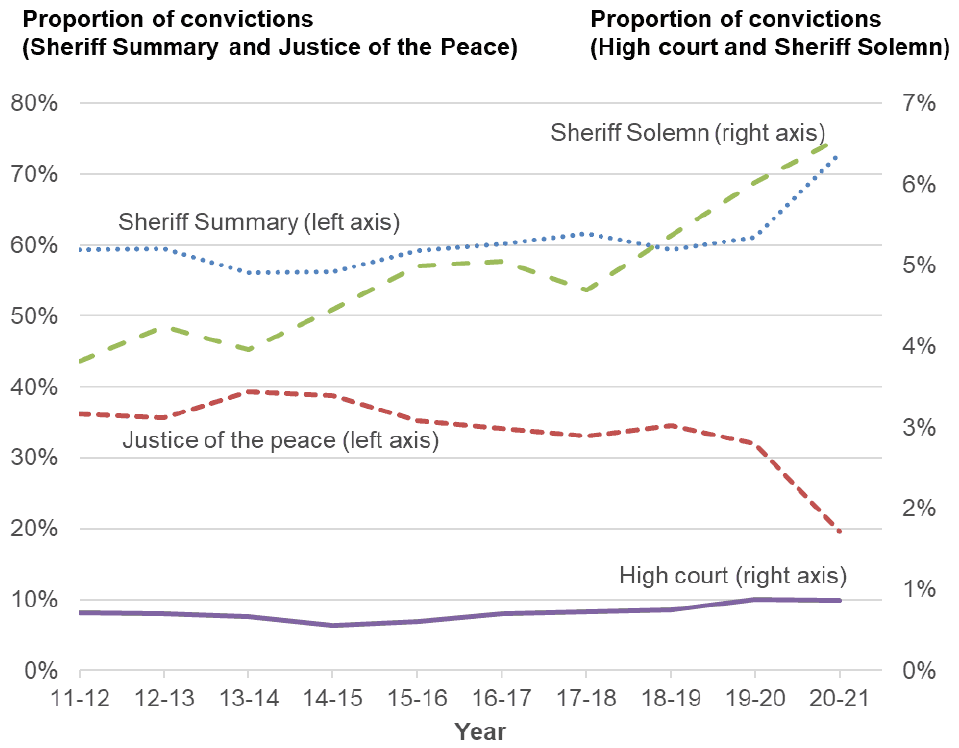Criminal proceedings in Scotland: 2020-2021
Statistics on criminal proceedings concluded in Scottish courts and alternative measures to prosecution issued by the police and the Crown Office and Procurator Fiscal Service are presented for the ten years from 2011-12 to 2020-21. The latest year’s data is impacted by the COVID-19 pandemic.
4. People convicted in court
(Table 3)
There are four main court types that deal with criminal cases in Scotland.
- The High Court, which deals with the most serious crimes such as murder, rape and armed robbery. The maximum penalty that may be imposed is up to life imprisonment and/or an unlimited fine. The exact maximum in a given case will be determined by any limit provided for in the statute creating the offence being prosecuted. A single judge hears cases with a jury of 15 people.
- Sheriff Courts, which deal with the majority of cases in Scotland. These can either be solemn, where the Sheriff sits with a jury of 15 people or summary, where the Sheriff sits alone [note 1]. For solemn cases the maximum penalty is 5 years' imprisonment and/or an unlimited fine and for summary cases, the maximum penalty that may be imposed (in most circumstances [note 2]) is 1 year’s imprisonment and/or a £10,000 fine.
- The Justice of the Peace courts. These deal with the less serious crimes, such as speeding, shoplifting and breach of the peace. They are chaired by a Justice of the Peace or “lay magistrate” who has been appointed from the local community and trained in criminal law and procedure. They can impose custodial sentences of up to 60 days and fines up to £2,500.
Chart 5 shows the changes in the proportion of convictions seen in each court type relative to 2011-12. Sheriff Solemn courts have risen from 4% of all convictions in 2011-12 to 7% in 2020-21. This increase in the proportion of more serious convictions is likely to be partly responsible for the increase in sentence lengths since 2011-12. The proportion of convictions in the sheriff summary increased most of any court type (by 14 percentage points), but the absolute number of convictions fell. The increase in the proportion of convictions in the sheriff summary courts is mostly due to decreases in the numbers seen in the JP courts. The proportion of cases seen in High Court has been broadly steady over the last decade.
The proportion seen in Sheriff Summary courts has increased by 12 percentage points over the past year, from 61% in 2019-20 to 73% in 2020-21.
Justice of the Peace courts accounted for 20% of convictions in 2020-21 compared to 32% in 2019-20.
- The number of convictions in Justice of the Peace courts has fallen by 65% from 24,200 in 2019-20 to 8,354 in 2020-21. The long-term fall in numbers of convictions in the JP courts, reflect decreases in the number of proceedings for motor offences, which the JP courts tend to deal with.
- Convictions in Sheriff Summary courts fell by 33% from 46,256 in 2019-20 to 31,014 in 2020-21. This follows a general downward trend in sheriff summary convictions since 2011-12, but this decrease is larger than it has been in the previous three years.
- The number of convictions in Sheriff Solemn courts decreased by 39% from 4,555 in 2019-20 to 2,795 convictions in 2020-21.
- The number of High Court convictions decreased by 44% in 2020-21 to 366 convictions (from 659 in 2019-20). Please note that recording delays are typical for high court activity due to the complex nature of cases held there. As a result, the total number of high court convictions for the most recent year may be slightly underestimated, and will likely be revised upwards next year. More information is available in the Annex revisions section.
Notes for Section 4. People convicted in court
Note 1. In a sheriff solemn court, the jury determines whether an accused is guilty or not and the sheriff determines sentence. In a sheriff summary court, the sheriff determines both whether an accused is guilty or not and, if guilty, the sentence.
Note 2. The court can sentence up to an additional six months where there is a bail aggravation on the charge, and Sheriff Court fines can be higher than £10,000 where there is legislative provision for this in relation to a specific offence.

Contact
Email: justice_analysts@gov.scot
There is a problem
Thanks for your feedback